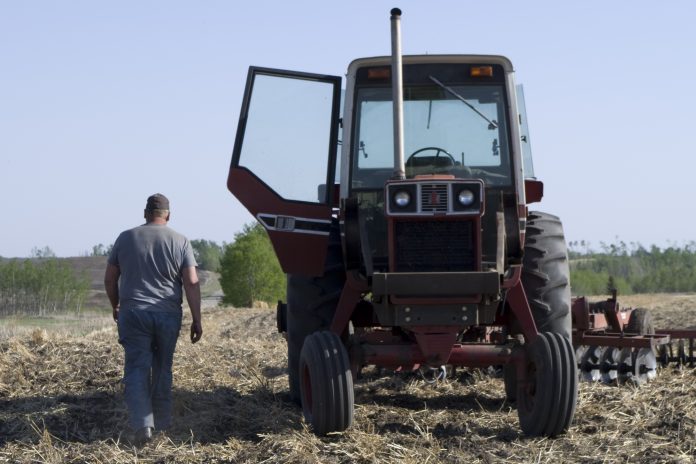Ministry of Agriculture
Submitted
Seeding is officially complete in Saskatchewan, with only two per cent of acres remaining unseeded in the province. Producers were excited to see rain showers move through the province this week after finishing seeding. While still busy in the field with pesticide application, many are watching as crops emerge and develop.
The majority of crops are in normal stages of development for this time of year. Fall cereals are slightly ahead in development at 31 per cent, while oilseeds are slightly behind in development at 16 per cent. Dry conditions in the west have induced environmental stress in crops and have hastened their development. Alternatively, the east received more moisture during the spring resulting in some localized flooding and has delayed development.
Recorded rain varied from half a mm in Consul to 65 mm of rain received in the Ituna area. Overall, the rain received throughout the province replenished the topsoil moisture conditions. Four per cent of cropland has a surplus of topsoil moisture, 69 per cent is adequate, 24 per cent is short and four per cent is very short.
Hay and pastures also benefitted from this week’s precipitation. Three per cent have a surplus of topsoil moisture, 57 per cent is adequate, 33 per cent is short and seven per cent is very short. Livestock water supplies are top of mind this week with 52 per cent of producers anticipating water shortages to occur this summer, while 46 per cent are already facing moderate water shortages. Many are concerned with water quality for their livestock. Producers with these concerns are encouraged to drop-off water samples at their local Ministry of Agriculture regional office for water quality testing.
Producers are currently busy scouting their fields and are spraying herbicides, fungicides and insecticides. There are concerns about grasshopper and gopher pressures.
For many producers, this is still a stressful time of year and producers are encouraged to take all safety precautions in all the work they do. The Farm Stress Line can help by providing support for producers toll free at 1-800-667-4442.
Northeastern Saskatchewan
Producers in the northeast region were able to seed all acres this year and are experiencing the least amount of environmental stress on crops, forages and pastures in the province. Five per cent of seeded, 10 per cent of forage and 13 per cent of pasture acres are experiencing environmental stress attributed to dry conditions. One per cent of forages are experiencing flooding.
Crops are the most advanced in the northeast compared to the rest of the province. Eighty-eight per cent of fall cereals, 35 per cent of spring cereals, 29 per cent of oilseeds and 27 per cent of pulses are ahead of normal development for this time of year. The majority of spring cereals, oilseeds and pulses are at normal stages of development for this time of year. Oilseeds are the furthest behind in development, with four per cent behind normal development for this time of year.
The Humboldt area received the most rain this week, with 37 mm of rain being recorded. The least amount of rain was recorded in the Star City area. Cropland topsoil moisture levels are at one per cent surplus, 83 per cent adequate and 16 percent short.
Hay and pasture topsoil moisture levels are rated at 80 per cent adequate and 20 per cent are short. Some livestock producers are anticipating water shortages this summer but are not too concerned about their water quality.
Producers in the region are currently spraying crops for pests, with grasshoppers being a primary concern for growers this year. Producers are also preparing for haying and are evaluating their hay stands. Although the region has adequate soil moisture, some producers are hoping for rain.
Northwestern Saskatchewan
With seeding being completed, many producers are now evaluating their crops. Producers in the northwest were able to seed all acres this year and are experiencing some environmental stress due to dry conditions. Twenty-one per cent of seeded, 34 per cent of forage and 37 per cent of pasture acres are experiencing environmental stress due to dry conditions. There is no reported damage due to flooding in the region.
Crops in the region are either at normal stages of development for this time of year or are ahead in development. Fall cereals are the most advanced, with 42 per cent of the crop ahead of normal development. Oilseeds are the most behind in development in the region, with nine per cent behind normal stages of development for this time of year.
The entire region received rain this week, ranging from 63 mm in the Shellbrook area to 15 mm in the Hafford area. Many producers are grateful for the moisture. The rain replenished topsoil moisture levels throughout the region. Four per cent of cropland topsoil has a surplus of moisture, 77 per cent is adequate, 15 per cent is short and four per cent is very short.
Hay and pasture topsoil moisture was also replenished with the rain this week. Five percent of hay and pasture topsoil has a surplus of moisture, 66 per cent is adequate, 23 per cent is short and seven per cent is very short.
The recent rain also alleviated some water supply pressure for livestock producers, although some are experiencing severe shortages and many are anticipating a shortage later in the year. Many are also concerned about the quality of the available water. Producers are currently applying in-crop pesticides and are scouting their fields, controlling grasshopper populations, working cattle and preparing for haying. All while watching their moisture levels closely and are hoping for additional rain showers.


